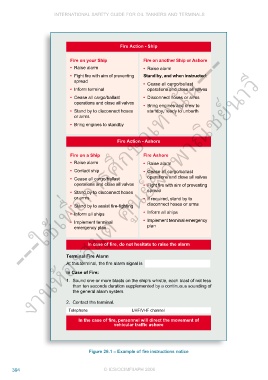Page 428 - International safety guide for oil tankers and terminals
P. 428
INTERNATIONAL SAFETY GUIDE FOR OIL TANKERS AND TERMINALS
---ใช้เพื่อการศึกษาเท่านั้น---
Fire Action - Ship
Fire on your Ship Fire on another Ship or Ashore
งานห้องสมุด ศูนย์ฝกพาณิชย์นาวี
• Raise alarm • Raise alarm
• Fight fire with aim of preventing Stand by, and when instructed:
spread
• Cease all cargo/ballast
• Inform terminal operations and close all valves
• Cease all cargo/ballast • Disconnect hoses or arms
operations and close all valves
• Bring engines and crew to
• Stand by to disconnect hoses standby, ready to unberth
or arms
• Bring engines to standby
Fire Action - Ashore
Fire on a Ship Fire Ashore
• Raise alarm • Raise alarm
ึ
• Contact ship • Cease all cargo/ballast
operations and close all valves
• Cease all cargo/ballast
operations and close all valves • Fight fire with aim of preventing
spread
• Stand by to disconnect hoses
or arms • If required, stand by to
disconnect hoses or arms
• Stand by to assist fire-fighting
• Inform all ships
• Inform all ships
• Implement terminal emergency
• Implement terminal
plan
emergency plan
In case of fire, do not hesitate to raise the alarm
Terminal Fire Alarm
At this terminal, the fire alarm signal is
In Case of Fire:
1. Sound one or more blasts on the ship’s whistle, each blast of not less
than ten seconds duration supplemented by a continuous sounding of
the general alarm system.
2. Contact the terminal.
Telephone UHF/VHF channel
In the case of fire, personnel will direct the movement of
vehicular traffic ashore
Figure 26.1 – Example of fire instructions notice
394 © ICS/OCIMF/IAPH 2006

